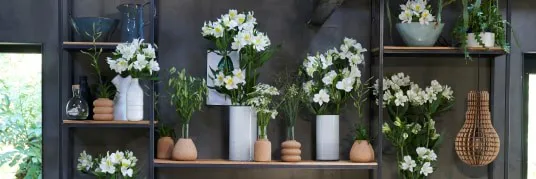Alstroemeria kicks off the indoor season in all the colours that this cut flower offers, with white being the utterly on-trend colour. What's unique about alstroemeria is that it saves its beauty for the right moment.
In the shop the flowers hide in their buds; it’s only after the customer gets them home that they will start to show off their full beauty.

Origin
Alstroemeria, also known as the Inca lily, originates from the cool mountain regions of the Andes in Brazil, Peru and Chile. The current production of alstroemeria as a cut flower takes place in greenhouses, where the plant is highly productive. The quality of the flowers has improved considerably in recent years, resulting in sturdy stems, attractive green foliage and a longer vase life.
Range and assortment
Although white plays the leading role in September to reinforce the feeling of a new start, alstroemeria features many different cultivars with fabulous clear, bright colours and markings on the flower. The flowers come in virtually all the colours of the rainbow. The markings can also range from entirely plain to spots or stripes on the petals. In terms of flower shapes, there are new forms such as double-flowered varieties and alstroemerias with very large flowers. There is also the spray alstroemeria Florinca, with sturdy stems, small flowers and a long vase life - up to 3 weeks.
Care tips for professionals
- Place Alstroemeria in clean buckets or vases with clean water with a preservative added. This ensures that the flowers open well, the leaves do not yellow, and the water is not contaminated by bacteria.
- Trim 3-5 cm off the stems with sharp secateurs or a sharp knife and remove the bottom leaves. Make sure that there’s no foliage in the water.
- Ensure that the flowers and the foliage cannot get damp due to excessive humidity or from condensation in the cellophane. This will encourage botrytis, a fungus which rapidly diminishes the decorative value. With alstroemeria, this is often called blight because of the small spots on the flowers, or grey mould when it is between the leaves.
Display tips for professionals
After the relaxed mood of the summer, September provides structure and the need for order again. For the styling of alstroemeria that means peace and rhythm to show the flower’s purity to its best advantage. There is also increasing interest in sustainability and accountability. Vases can hint at re-use (painted bottles) or multifunctionality (vases that can also serve as a jug or carafe). This creates a harmonious coherence in which you retain an overview. The supporting colours can be muted: white, grey, black, blue and a hint of russet.
Inspiration & information
Inspiring images of every flower on the Flower Agenda have been produced in line with the Horticulture Sector Trends 2019 (Groenbranche Trends 2019). These trends are a translation of the latest consumer trends and are specifically aimed at the horticulture sector for use both indoors and outdoors. If you would like to find out more about the Flower Agenda, click here.
Source: Flower Council of Holland
